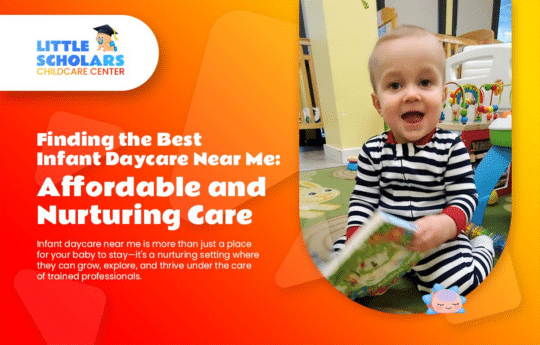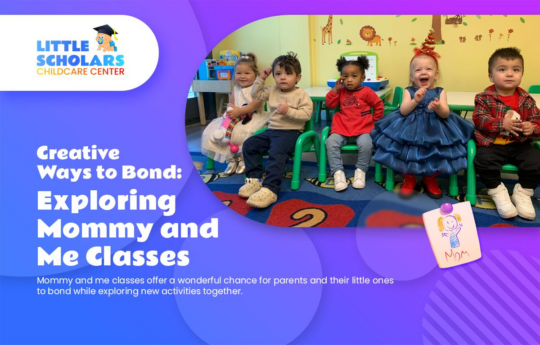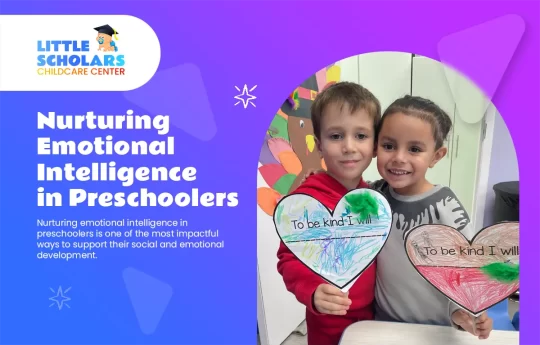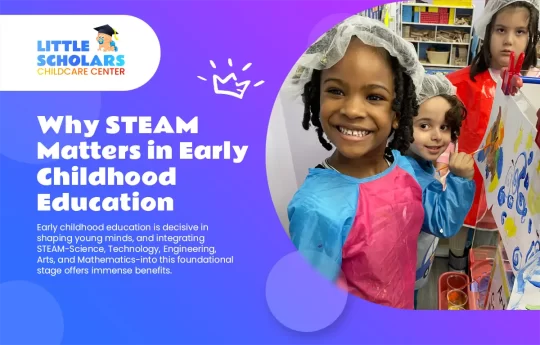
STEAM education in early childhood lays the foundation for curiosity, creativity, and critical thinking—essential skills that shape a child’s lifelong learning journey. By fusing Science, Technology, Engineering, Arts, and Mathematics into early education, children engage in hands-on exploration that nurtures problem-solving and innovation.
Early exposure to STEAM ensures that children develop foundational knowledge and the ability to navigate challenges creatively in today’s fast-evolving world. Investing in STEAM education from the start helps young minds flourish, turning everyday moments into opportunities for discovery and growth.
Exploring the Benefits of STEAM Education in Early Childhood
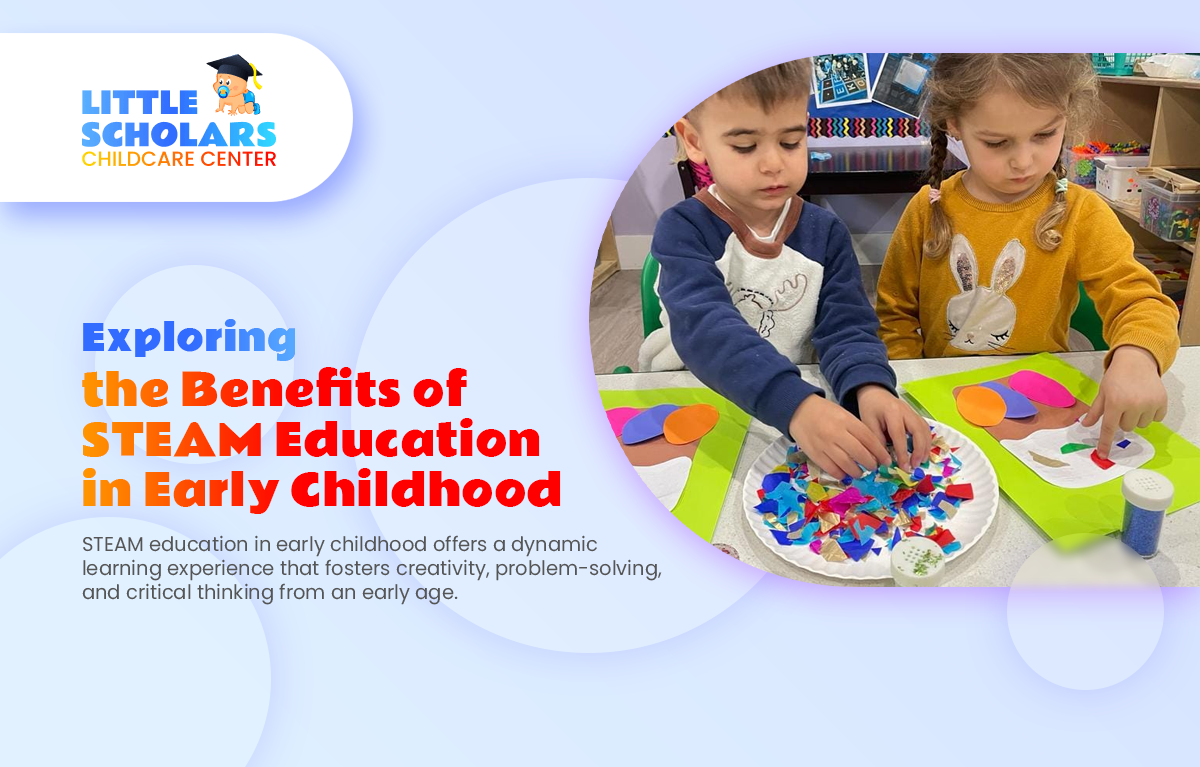
STEAM education in early childhood offers a dynamic learning experience that fosters creativity, problem-solving, and critical thinking from an early age. Unlike traditional methods, STEAM engages children in real-world problem-solving, making learning exciting and meaningful.
Fostering Creativity and Innovation
Young children are naturally curious, and STEAM education enhances their ability to explore, experiment, and think creatively. When children engage in hands-on projects, they develop problem-solving skills that encourage them to think outside the box.
- Encouraging open-ended exploration: STEAM activities often involve projects with no single “correct” answer, allowing children to develop creative solutions.
- Blending logic with imagination: Combining the arts with science and technology enables children to approach learning from multiple perspectives.
- Developing hands-on problem-solving: Interactive experiments and engineering challenges teach children to build, test, and refine their ideas.
Children develop a strong foundation for future academic and personal success by engaging in STEAM-based learning. These experiences help them see challenges as opportunities to innovate rather than obstacles to overcome.
Strengthening Critical Thinking and Problem-Solving Skills
One of the greatest perks of STEAM education is its ability to enhance a child’s ability to think critically and solve problems independently. Instead of simply memorizing information, children learn to investigate, analyze, and apply their knowledge in real-world situations.
- Promoting inquiry-based learning: STEAM education encourages children to ask questions, find possibilities, and experiment with different outcomes.
- Teaching cause-and-effect reasoning: Hands-on projects help children understand how their actions produce specific results, reinforcing logical thinking.
- Boosting decision-making skills: Children learn to evaluate choices and make informed decisions by exploring multiple solutions.
Through these experiences, children develop a problem-solving mindset that will benefit them throughout their education. These skills prepare them to adapt to future academic and life challenges confidently.
Enhancing Social and Emotional Development
Beyond academics, STEAM education nurtures essential social and emotional skills that are key to a child’s overall development. Many STEAM activities involve teamwork, communication, and collaboration, helping young learners develop interpersonal skills to benefit them in every aspect of life.
- Encouraging teamwork and cooperation: Group projects teach children to collaborate, share ideas, and respect different viewpoints.
- Improving communication skills: Discussing ideas and explaining problem-solving methods help strengthen language development and self-expression.
- Building resilience and perseverance: Learning through trial and error helps children understand that mistakes are part of learning.
These experiences teach children patience, empathy, and collaboration—skills that will help them succeed in school and future professional and personal settings.
Preparing Young Learners for Future Academic Success
As technology and innovation evolve, early exposure to STEAM concepts equips children with the knowledge and adaptability they will need in a rapidly changing world. STEAM-based learning fosters curiosity, making subjects more engaging and accessible.
- Sparking a love for learning: STEAM education makes subjects exciting, encouraging children to develop a passion for discovery.
- Promoting adaptability and innovation: Hands-on problem-solving activities teach children to approach challenges creatively and flexibly.
- Bridging learning gaps: STEAM activities provide accessible, engaging ways for children of all backgrounds to develop core academic skills.
By introducing STEAM concepts early, educators and parents help young learners develop a growth mindset that will serve them well in their academic path.
What Makes a Strong STEAM Curriculum for Preschool?
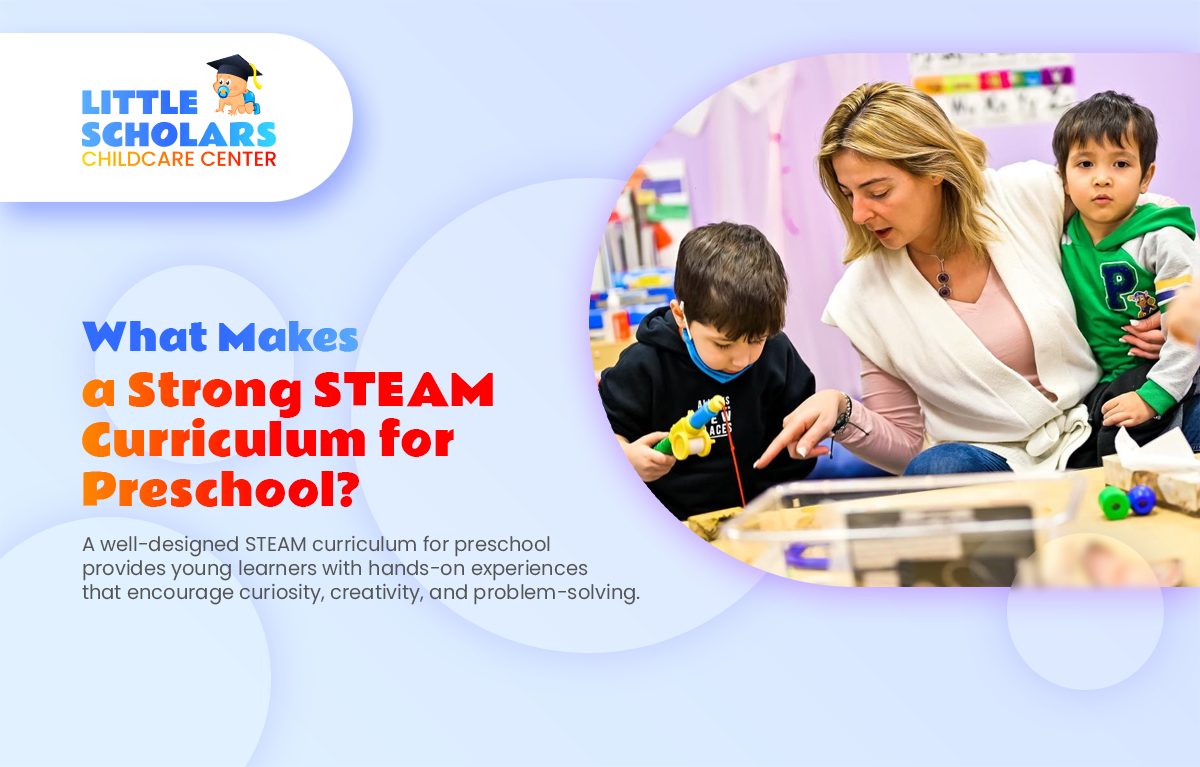
A well-designed STEAM curriculum for preschool provides young learners with hands-on experiences that encourage curiosity, creativity, and problem-solving. The key to an effective curriculum is creating a structured yet flexible learning setting where children can explore, experiment, and gain essential skills through play-based activities.
Key Components of an Effective STEAM Curriculum
A successful preschool STEAM curriculum should be designed to stimulate young minds while creating a love for learning. The best programs seamlessly integrate STEAM concepts into everyday activities, ensuring children develop a strong foundation in multiple disciplines without feeling overwhelmed.
- Hands-on exploration: Activities should be interactive and encourage children to experiment with different materials, tools, and ideas.
- Play-based learning: STEAM concepts should be introduced through games, storytelling, and creative projects that make learning fun.
- Real-world connections: Lessons should be designed to help children understand how STEAM applies to the world around them, making abstract concepts more relatable.
By incorporating these elements, preschools can create a stimulating learning environment where children feel excited to explore new ideas while developing problem-solving and critical-thinking skills.
Encouraging Inquiry-Based Learning
Inquiry-based learning is at the heart of a strong STEAM curriculum for preschool, as it empowers children to ask questions, investigate, and find solutions independently. Instead of providing direct answers, educators guide children through the discovery process, encouraging them to think critically and experiment.
- Asking open-ended questions: Teachers should encourage children to explore their thoughts and ideas rather than focusing on right or wrong answers.
- Providing opportunities for discovery: Setting up hands-on experiments and sensory activities allows children to learn through direct experience.
- Supporting problem-solving: Encouraging children to think creatively and test different solutions helps build resilience and confidence in their abilities.
This approach helps children develop independence and fosters a deep and lasting interest in learning.
Integrating the Arts into STEM Learning
Including the Arts in STEAM education is crucial for fostering creativity and self-expression. Art-related activities help children develop fine motor skills, visual-spatial awareness, and an appreciation for innovation, complementing traditional STEM subjects.
- Encouraging creative expression: Activities like painting, music, and drama help children connect with STEAM concepts uniquely.
- Enhancing problem-solving through design: Engineering challenges and building projects encourage children to think critically while creating something new.
- Developing storytelling skills: Combining science and art through activities like puppet shows or digital storytelling enhances communication and imagination.
A STEAM curriculum incorporating artistic elements ensures that children develop technical skills and become innovative thinkers who can approach challenges from multiple perspectives.
Making Learning Interactive and Engaging
A preschool STEAM curriculum should focus on making learning exciting and hands-on. When children actively engage in learning, they retain information more effectively and develop a genuine enthusiasm for exploration.
- Using sensory-rich materials: Incorporating different textures, sounds, and visual elements enhances learning experiences.
- Encouraging teamwork: Group projects help children develop communication and social skills while working together on fun, collaborative activities.
- Incorporating technology: Age-appropriate digital tools like interactive apps or simple coding games can playfully introduce basic tech concepts.
Educators create an engaging and interactive learning setting to help young learners gain a strong foundation in STEAM subjects while fostering a lifelong love for discovery.
Early Childhood Learning Strategies for a STEAM-Based Approach
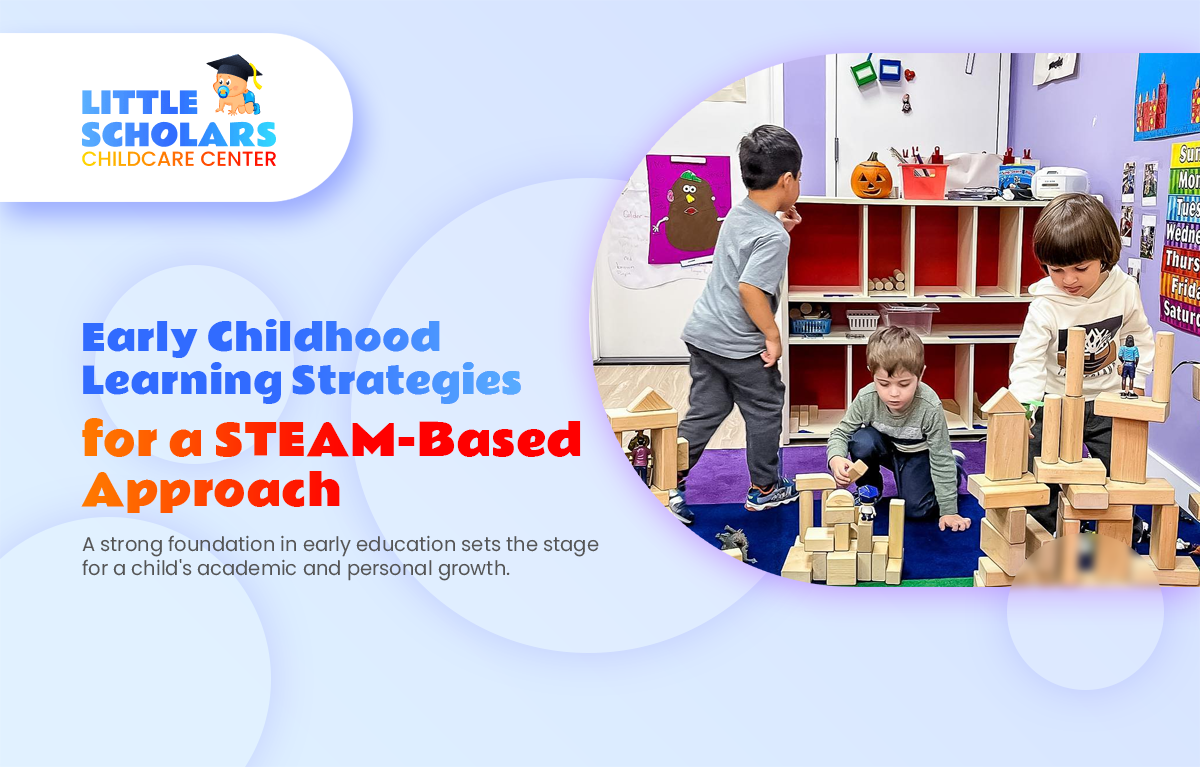
A strong foundation in early education sets the stage for a child’s academic and personal growth. Educators and parents can foster curiosity, problem-solving, and creativity in young learners by integrating early childhood learning strategies into a STEAM-based approach.
Encouraging Hands-On Exploration
Children learn best when interacting with their environment and engaging in hands-on activities. A STEAM-based approach emphasizes active learning, allowing children to independently experiment, observe, and discover new ideas.
- Incorporating sensory play: Activities like water play, sand experiments, or mixing colors help children explore scientific concepts fun and tactilely.
- Using building materials: Blocks, LEGO, and recycled materials encourage problem-solving and engineering skills through creative construction.
- Introducing real-world problem-solving: Simple experiments, such as testing which materials float or sink, help children understand cause and effect.
Hands-on learning makes abstract concepts more concrete, helping young learners grasp ideas that might otherwise seem too complex.
Promoting Inquiry-Based Learning
Inquiry-based learning makes children ask questions, investigate ideas, and seek answers through exploration. This approach fosters curiosity and helps children develop critical thinking skills from an early age.
- Asking open-ended questions: Instead of providing direct answers, encourage children to think outside the box by asking, “What do you think will happen?”
- Allowing for trial and error: Encouraging children to make predictions and test their ideas fosters resilience and adaptability.
- Supporting self-directed learning: Giving children the freedom to explore topics that interest them builds independence and motivation.
Inquiry-based learning helps children develop a deeper understanding of the world by nurturing curiosity.
Integrating Play with Learning
Play is a natural way for young children to learn, and incorporating play-based strategies into a STEAM curriculum makes learning more enjoyable and effective. Play allows children to explore new ideas while developing social, emotional, and cognitive skills.
- Encouraging role-playing: Pretend play scenarios like “little scientists” or “mini engineers” help children connect STEAM concepts to real-life situations.
- Using storytelling and music: Songs, stories, and movement-based activities make learning interactive and memorable.
- Creating open-ended challenges: Giving children STEAM-based puzzles or games encourages creativity and independent thinking.
By blending structured learning with play, children remain engaged while building foundational skills that will benefit them in the future.
Supporting Collaboration and Teamwork
STEAM education emphasizes teamwork, helping children develop communication and cooperation skills essential for future success. Collaborative learning allows children to share ideas, learn from each other, and develop a sense of belonging.
- Encouraging group projects: Simple tasks like building structures or conducting small science experiments teach teamwork and problem-solving.
- Teaching turn-taking and active listening: Children learn to respect others’ ideas and communicate effectively in group activities.
- Fostering leadership skills: Assigning small responsibilities within a group helps children build confidence and independence.
Working together helps young learners develop the social skills needed to thrive in academic and everyday settings.
Conclusion
STEAM education in early childhood isn’t just about learning—it’s about igniting curiosity, fostering creativity, and building a strong foundation for lifelong success. Introducing young learners to hands-on exploration, problem-solving, and teamwork empowers them to think critically, adapt to challenges, and embrace innovation. A well-structured STEAM curriculum nurtures their natural sense of wonder, helping them see the world as a place full of possibilities.
Ready to give your child the best start with STEAM-based learning? Book a tour at Little Scholars NYC and experience our engaging, hands-on approach firsthand! Call us at +1 (929) 269-8756 or schedule your visit today: https://littlescholarsnyc.com/littlescholarsnyc-childrens-center-tour/

